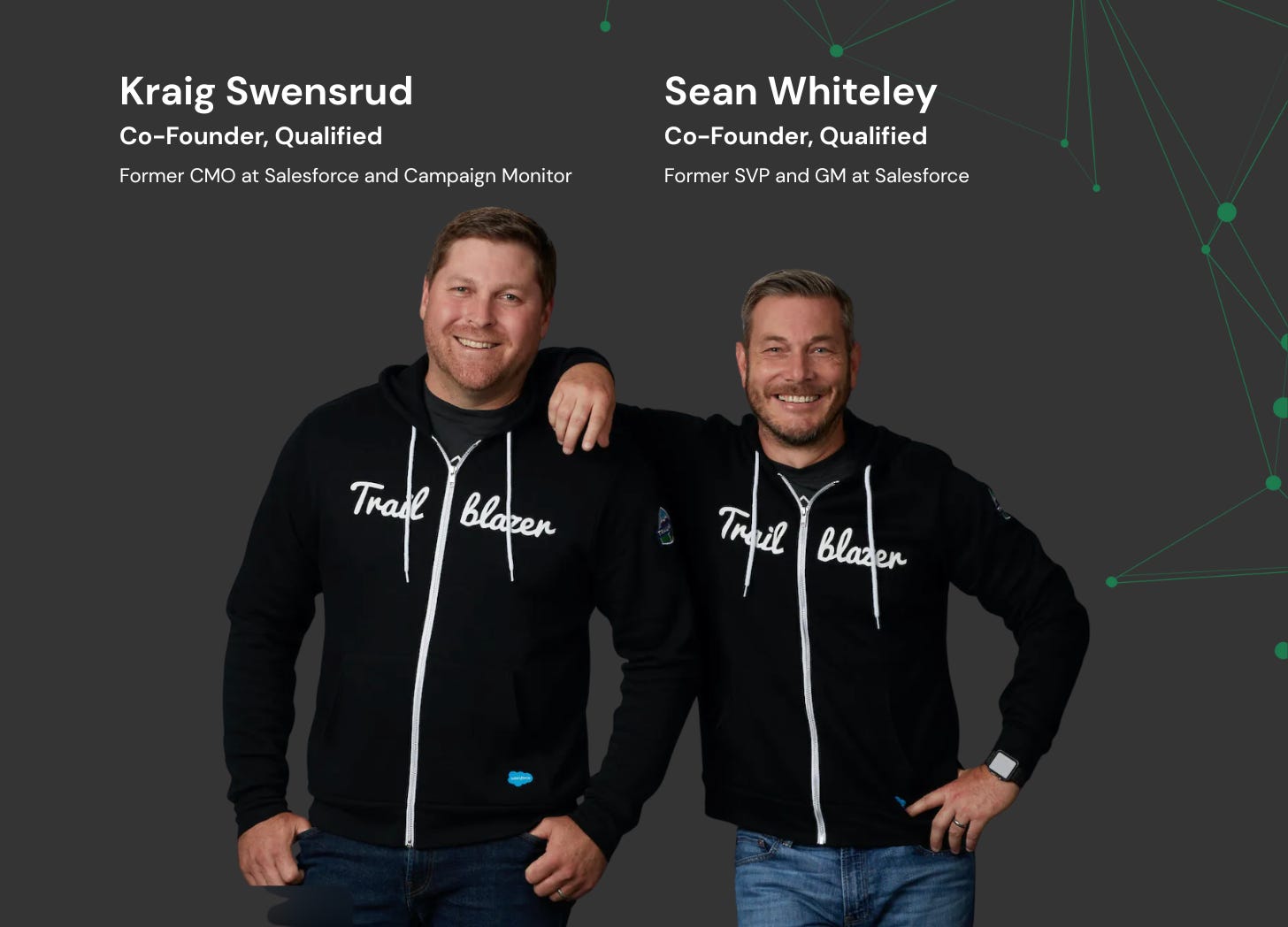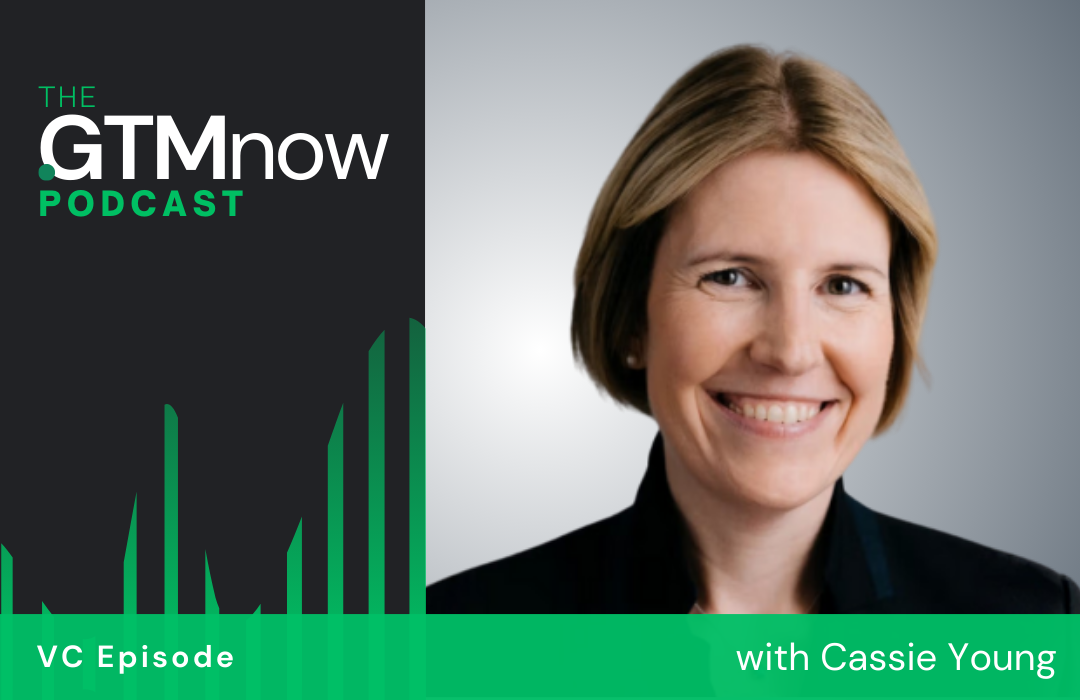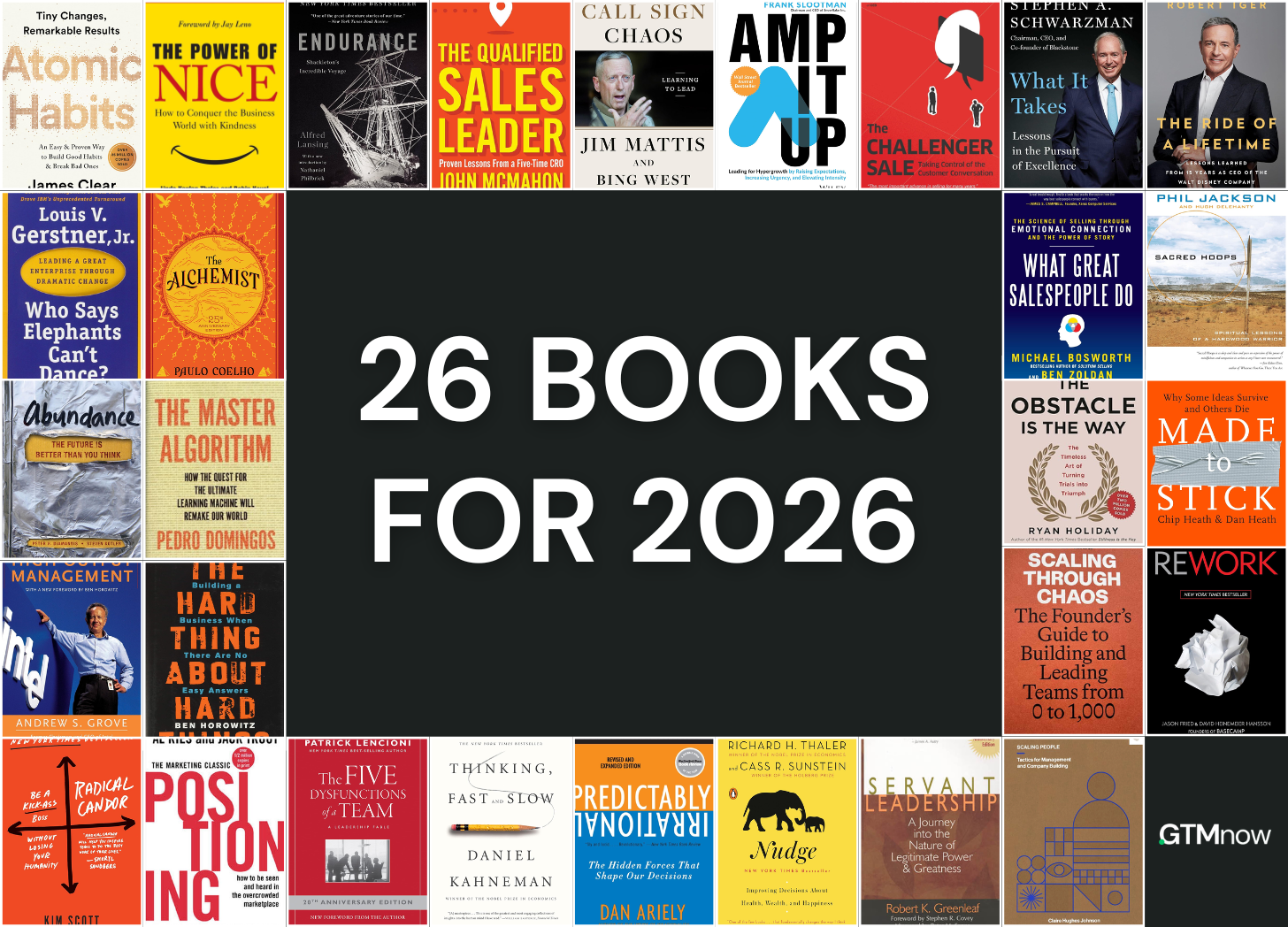The GTM Moat Series: In AI, Brand is the Foundation of Your Moat
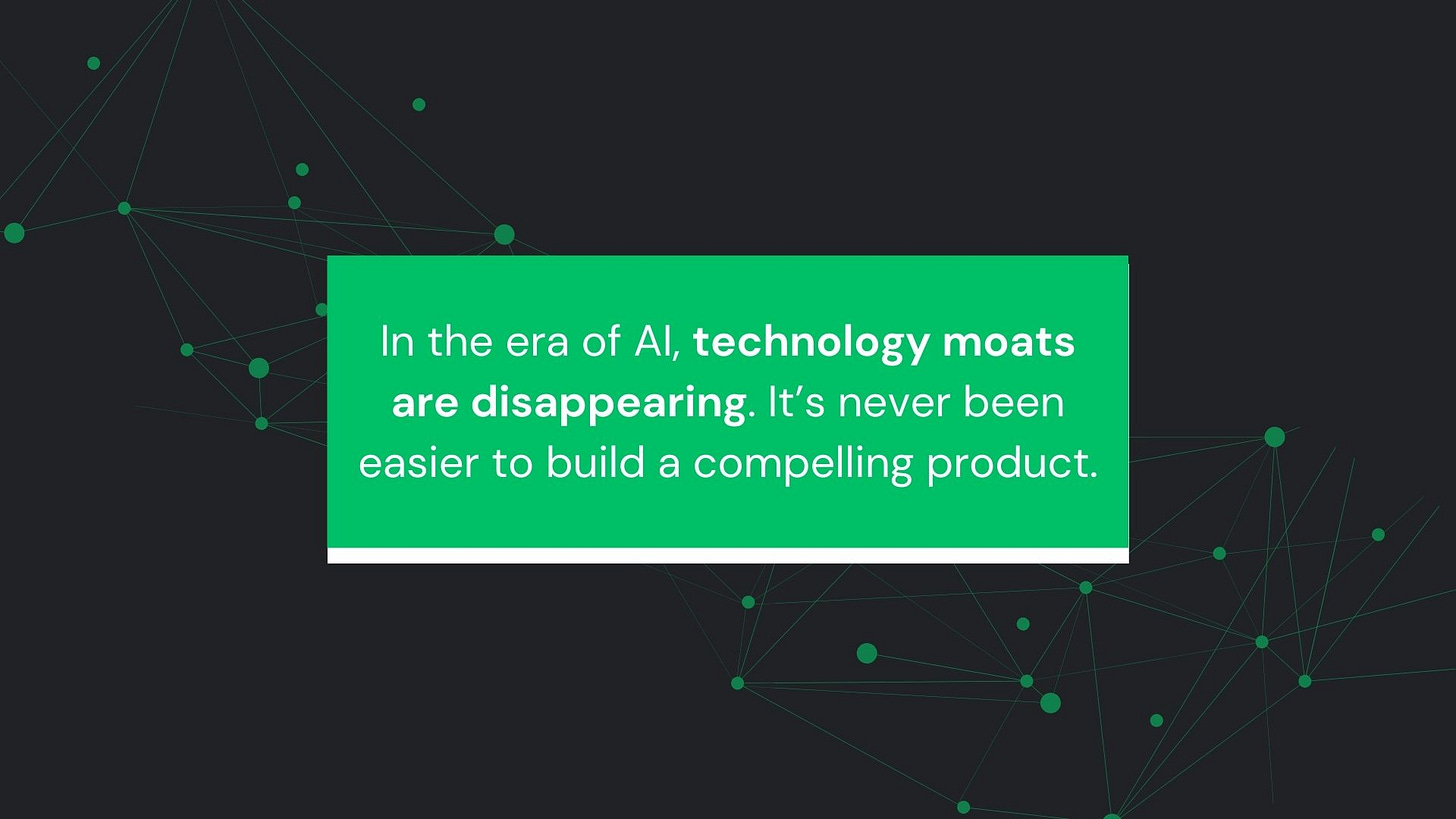
Hello and welcome to The GTMnow Newsletter – the media brand of VC firm, GTMfund.
This is Part 1 of a Series on how to build your GTM moat.
You stayed up all weekend building your AI product.
You launch Monday. By Wednesday, there are five clones.
One has your tagline, two raised a Seed round.
None feel like yours.
In AI, your tech is no longer your moat.
Distribution is your moat, and brand is the foundation of it. Go-to-market is the engine that drives it.
Before the AI tidal wave, before OpenAI hit 100 million users in two months, and before “wrapper fatigue” became a meme, we built GTMfund’s thesis:
Distribution is the final remaining moat.
We believe the next generation of iconic B2B companies will be built on superior distribution and execution.
These have been and will continue to be the first and second slides (after the title slide) of our fund decks:

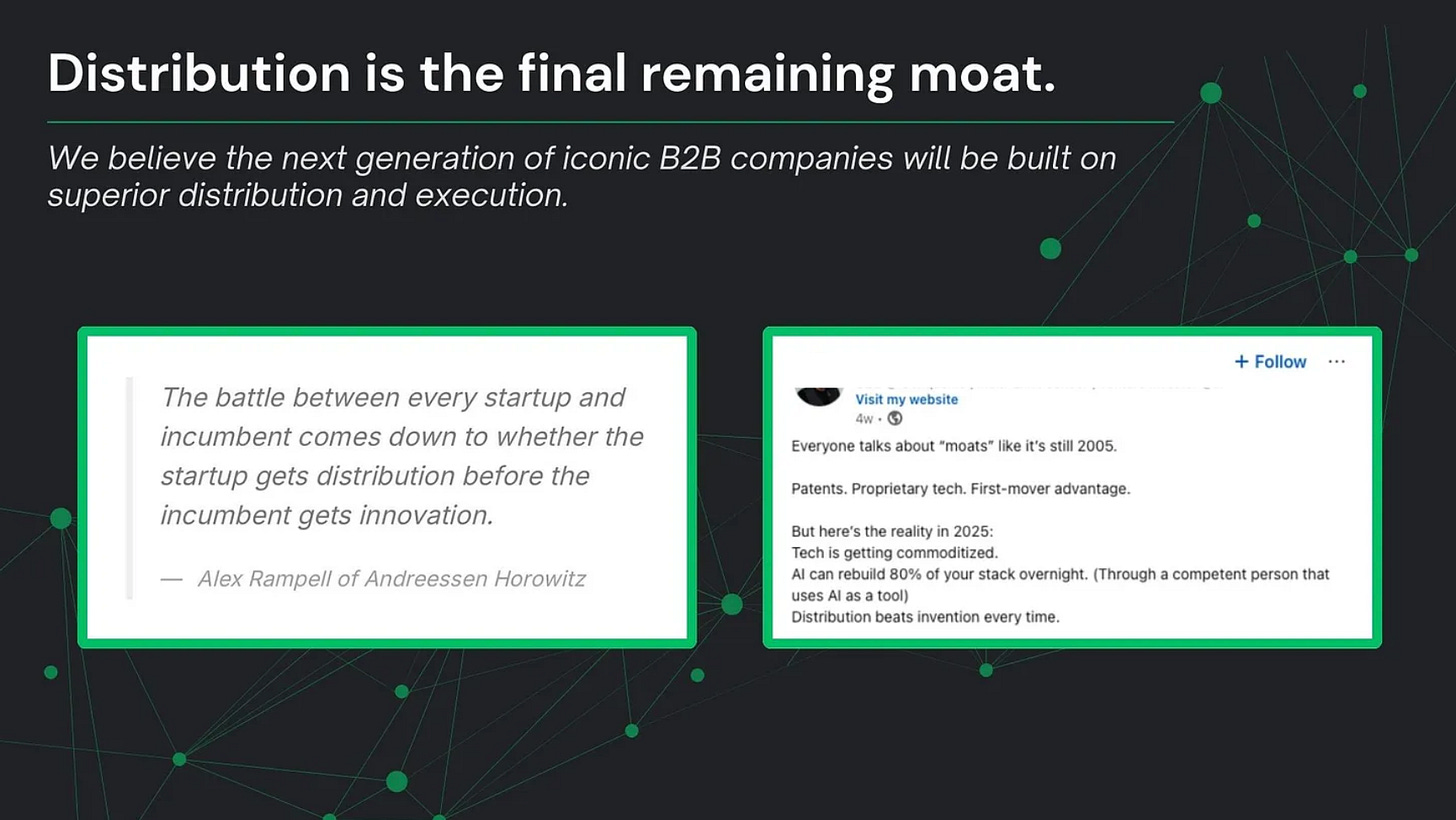
Writing a piece on brand being a moat feels inevitable. It’s been a core belief from the beginning, and will only continue to increase in importance.
These slides have remained that way for over four years. The case is only stronger:
- LLMs are commoditized.
- Features are copied in a weekend.
- Competition is infinite, attention is scarce.
- Fundraising is hot again – $100B+ in AI funding in 2024 alone.
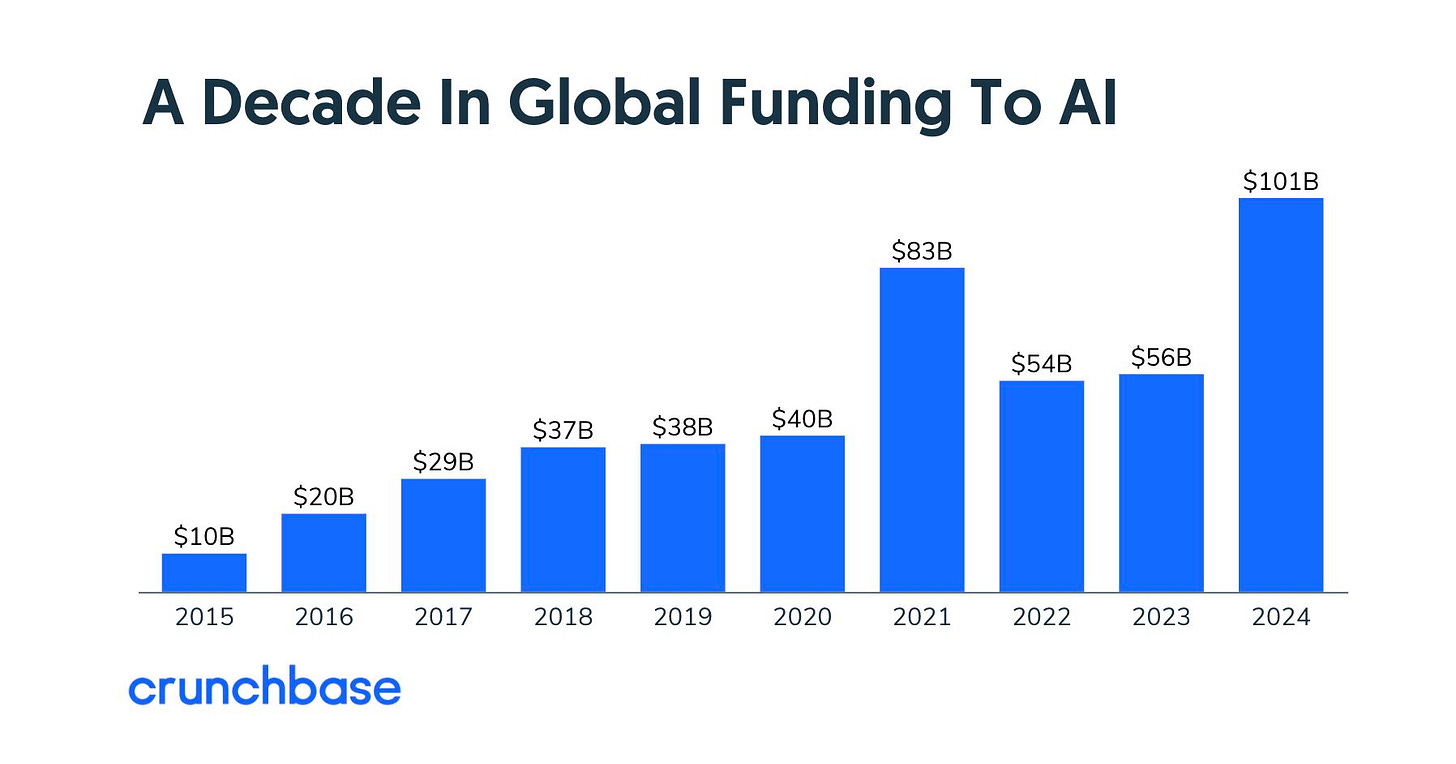
Plus, a handful of AI companies like OpenAI and Anthropic alone raising tens of billions of dollars.
The paradox?
It’s never been easier to ship.
It’s never been harder to build something that sticks.
So what do you do when your tech moat evaporates?
You build a distribution moat, and brand is the foundation.
The companies that break out (even in crowded, commoditized markets) do so because they craft a clear Promise, a distinct Personality, and a visible, credible set of People behind the product.
This is Part 1 of a Series on how to build your GTM moat.
Brand is a strategy
Some of the most iconic companies in the world demonstrate the impact of brand by building it as a strategy.
Steve Jobs understood this better than anyone. When he returned to Apple in the late 1990s, the company was bloated and sliding negatively. His first move was to focus on rebuilding the brand from its core.
“Marketing is about values,” he told the team. “We’re not going to get a chance to get people to remember much about us… So we have to be really clear about what we want them to know about us.”
Elon Musk took a different route, but with the same intent.
“Brand is just a perception, and perception will match reality over time.”
Tesla famously spent $0 on advertising in its early years. Instead, Musk focused on making the product so good that customers would do the distribution for him. In his world, brand wasn’t something you bought, it was something you earned by exceeding expectations and trusting that perception would follow reality.
Jeff Bezos, meanwhile, framed brand as something you can’t directly control – only earn.
“Your brand is what people say about you when you’re not in the room.”
At Amazon, that meant optimizing for customer trust from the very beginning. Fast delivery, obsessive support, and relentless convenience weren’t just operational decisions, they were brand investments. If you do build a great experience, customers tell each other about that. Word of mouth is very powerful.
And Marc Benioff? He built Salesforce on a single belief: that trust is the foundation of everything.
“Trust has to be your highest value. If it’s not, something bad is going to happen.”
Salesforce proved that it was reliable with real-time status dashboards and a cultural mandate to make customer success the company’s core product.
Across all of these examples, the pattern is clear:
Brand is what you build, show, and prove – from the very beginning.
It drives distribution, fuels retention, and builds trust. Brand becomes your most defensible moat.
We’re not talking about logos, fonts, or a Notion doc full of adjectives. We’re talking about brand as a day-zero tactical lever for:
- Distribution
- Retention
- Trust
- Differentiation
- Defensibility
The value is obvious at these later-stage companies, but also echoed across the earliest stages. Take this example from a startup that has been growing astronomically, Default:
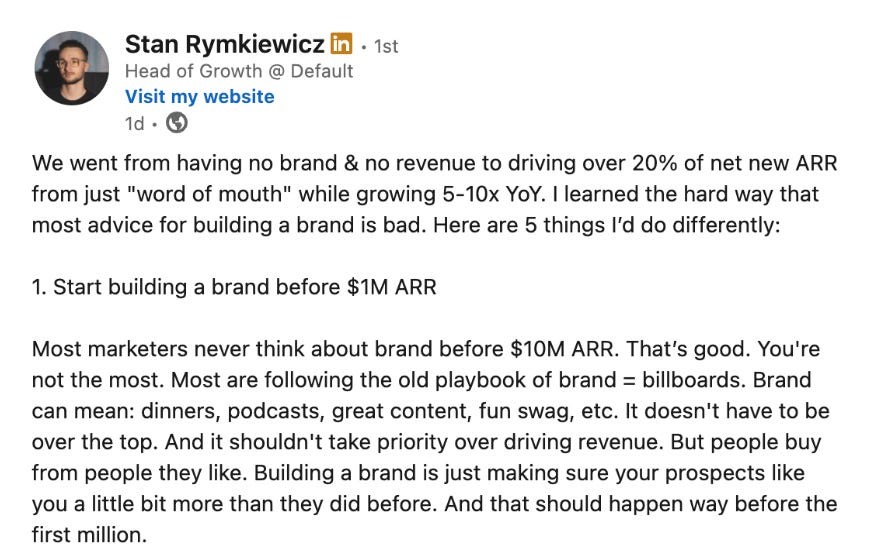
After working with hundreds of early-stage startups, we’ve seen that breakout companies (especially in AI) build brand on three foundational pillars.
The 3 pillars of a defensible early-stage brand
1. The Promise (what you do)
This is your biggest wedge. It’s the specific, repeatable, urgent outcome you deliver (not a vague mission statement).
A clear promise creates a repeatable narrative, both internally and externally. It drives word-of-mouth, champion enablement, and homepage copy.
Take these examples from companies as inspiration:
- Gong: Turn customer conversations into strategic growth.
- Loom: Faster than typing. Built for hybrid teams.
- Linear: The issue tracker you’ll actually enjoy using.
2. The Personality (how it feels)
Your tone, visuals, motion design, and UX are the emotional layers that makes your product memorable and human.
Take these examples from companies as inspiration:
- Notion: Calm, sophisticated, precise
- Superhuman: Intense, elite, high-performance
- Webflow: Creative, empowering, competent
To build this, choose 3–5 adjectives. Build every detail – from loading states to error messages – around them. That’s how you build emotional differentiation at scale.
3. The People (who you are)
Early users don’t trust the product, they trust you.
Your brand is a reflection of the founding team’s credibility, point of view, and proximity to the problem. In AI, where everything feels abstract, being visible, human, and intentional helps create that moat.
Take these examples from companies as inspiration:
- Descript: Andrew Mason brought quirky creativity and media fluency.
- Webflow: Vlad Magdalin made bootstrapping and belief central to the narrative.
- Loom: Joe Thomas turned product updates into a community conversation.
Meet your customers where they are.
Every founder thread, podcast, and product video is a brand artifact. Don’t treat them as “marketing,” treat them as moat-building assets.
The Day-Zero brand playbook
Step 1: Run the “brand pillars sprint”
Get the team aligned on:
- Promise: Who’s it for? What urgent outcome do we deliver?
- Personality: What does it feel like to use us?
- People: Why are we the team to solve this?
Create a one-page cheat sheet for every GTM and UX decision.
Step 2: Bake brand into product UX
Your UI is your brand and the most defensible expression of your identity.
Take these examples from companies as inspiration:
- Perplexity’s citations: Proof of accuracy baked into every result.
- Midjourney’s Discord UI: Feels like a live creative lab.
- Runway’s dark mode aesthetic: Signals sophistication and professionalism.
Even your microcopy (from loading bars to 404s) should reinforce your voice.
Step 3: Use content as proof
Content is your brand in motion. Use it to show your brand.
An effective way of doing this is through “IP” data – data that is unique to your company. Gong has over $300M ARR and pioneered this with Gong Labs.
They turned proprietary data from millions of sales calls into a repeatable content engine. This created evergreen insights that fuel authority, awareness, and trust across the entire sales ecosystem.
Every post reinforces their core brand promise: this is the place to go for truth in sales.
Other companies are effectively running this playbook also, like Carta. They get hundreds of thousands of likes, comments, and reposts on posts like this. The proprietary data they use for their content demonstrates depth and domain ownership that others can’t replicate.
Carta’s playbook for viral data storytelling can be read here.
Step 4: Founder as Chief Brand Officer
The founder is the first and most powerful brand channel.
- Share product decisions and GTM learnings.
- Document the early journey — wins and stumbles.
- Be the narrative before anyone else defines it for you.
Founders who build in public attract talent, trust, and traction. If you haven’t read Founder Brand by Dave Gerhardt, this is a masterclass in founder-led brand building.
Not everyone needs to operate at Elon Musk’s pace (nearly 100 tweets per day) but it proves just how valuable owning the narrative can be when building in public.
The only thing they can’t copy
Your tech will be cloned.
Your features will be matched.
Your pricing will be undercut.
But the promise you make, the feeling you create, and the trust you earn – that’s your moat. And it’s built from Day Zero.
Tag GTMnow so we can see your takeaways and help amplify them.
Recommendations

UserEvidence is the customer evidence platform for GTM teams. UserEvidence makes it easy to collect customer feedback throughout the customer lifecycle, curate the best proof points, and share it with your GTM team to use.
They also publish resources to help you do so, like this great one:
This resource gives you 7 ready-to-use survey templates to help you collect the customer evidence today’s buyers demand. Trust is everything and the market is getting more competitive. You need more proof, and you need it faster. These templates make it easy.
Grab the templates built from 10+ years of survey design experience and start gathering customer evidence that sells.
More for your eardrums
Stevie Case is the Chief Revenue Officer at Vanta, the leader in trust management and compliance automation. Since joining in 2021, Stevie has scaled the company from sub-$20M ARR to north of $100M, navigated 40+ copycat competitors, and led Vanta’s expansion from SMB into enterprise.
Vanta just raised a $150M Series D and is now valued at over $4 billion.
Listen on Apple, Spotify, YouTube, or wherever you get your podcasts by searching “The GTMnow Podcast.”
Startups to watch
Document Crunch – launched CrunchAI™ for Specifications — built for pre-construction and project teams who need to catch scope gaps, vague terms, and hidden risks before they become costly disputes. Extending its AI Risk Reduction Platform beyond contracts, it helps estimators, PMs, and field teams protect profits, deliver on schedule, and build with clarity and trust. Document Crunch also just placed No. 311 on the 2025 Inc. 5000 list, ranking in the top 6% of the fastest-growing private companies in America, and No. 29 in Software category nationwide.
Opus – released the waitlist for Agent Opus, the first AI video agent built for social that turns your ideas into scroll-stopping videos across YouTube, TikTok, LinkedIn, and more. Eight specialized AI agents handle everything from research and scripting to hook design, motion graphics, and editing. You can join the waitlist here.
Anything – after racking up 3.2M views and 550K+ users at launch, is redefining how software gets built. Its AI agent turns a simple prompt into fully functional mobile and web apps, all in minutes, no code required. It just went live on Product Hunt – show some love with an Upvote.
More for your eyeballs
ZoomInfo CRO James Roth shares how he hires transformational GTM talent while processing thousands of applications. From the “Calculator Test” that exposes fake performers, to sourcing 90% of VP+ hires from his customer/vendor network, to targeting performance-background candidates who thrive on tough feedback.
Clari and Salesloft are merging to create a $10T “Revenue AI” powerhouse, uniting billions of buyer signals to transform how teams close deals. Not without some commentary from Gong’s CEO.
Hottest GTM jobs of the wek
- Senior Software Engineer – Full Stack at Amper (Remote – Chicago)
- Staff Software Engineer at Esper (Austin, TX)
- Lifecycle Marketing Manager at Gorgias (Paris, France)
- Founding NYC Software Engineer at Equi (NY, USA)
- Supply Associate at Patch (San Francisco, USA)
See more top GTM jobs on the GTMfund Job Board.
If you’re looking to scale your sales and marketing teams with top talent, we couldn’t recommend our partner Pursuit more. We work closely together to be able to provide the top go-to-market talent for companies on a non-retainer basis.
GTM industry events
Upcoming go-to-market and VC events you won’t want to miss:
- INBOUND 2025: September 3-5, 2025 (San Francisco, CA)
- GTMfund Dinner SF (private registration): September 10, 2025 (San Francisco, CA)
- Pavilion GTM Summit: September 23-25, 2025 (Washington, DC)
- Dreamforce: October 14-16, 2025 (San Francisco, CA)
- GTMfund Dinner (private registration): October 22, 2025 (Austin, TX)
- GTMfund Dinner (private registration): November 18, 2025 (Toronto, ON)
- GTMfund Dinner (private registration): November 19, 2025 (New York, NY)
- GTMfund Dinner (private registration): November 19, 2025 (New York, NY)

